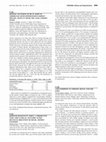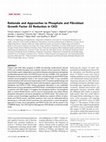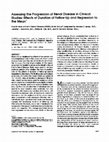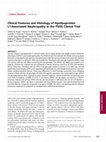Papers by Jennifer Gassman

Journal of the American Society of Nephrology : JASN, Jan 4, 2017
The magnitude of decline in renal function that should be tolerated during intensive BP lowering ... more The magnitude of decline in renal function that should be tolerated during intensive BP lowering and its association with risk of ESRD are unclear. To determine whether the acute declines in kidney function in the intensive BP lowering arm of two trials in CKD associated with higher risk of ESRD, we performed a retrospective study of 899 African American Study of Kidney Disease and Hypertension (AASK) and 761 Modification of Diet in Renal Disease (MDRD) Trial participants previously randomized to strict versus usual BP control. The predictor was the percentage decline in eGFR (<5%, 5% to <20%, or ≥20%) between randomization and months 3 and 4 of the trial (time to achieve BP goals). ESRD was the outcome of interest. Compared with a <5% eGFR decline in the usual BP arm, a 5% to <20% eGFR decline during intensive BP lowering did not associate with a higher risk of ESRD in the AASK (adjusted hazard ratio [aHR], 1.19; 95% confidence interval [95% CI], 0.84 to 1.68) or the MD...

Kidney international, 2017
Although APOL1 high-risk genotype partially accounts for the increased susceptibility of blacks t... more Although APOL1 high-risk genotype partially accounts for the increased susceptibility of blacks to chronic kidney disease (CKD), whether APOL1 associates differentially with mortality risk remains controversial. Here we evaluate the association between APOL1 genotype and risk of death and determine whether APOL1 status modifies the association between strict versus usual blood pressure control and mortality risk. We performed a retrospective analysis of the African American Study of Kidney Disease and Hypertension trial that randomized black participants with CKD to strict versus usual blood pressure control from 1995 to 2001. This included 682 participants with known APOL1 genotype (157 with high-risk genotype) previously assigned to either strict (mean arterial pressure [MAP] 92 mm Hg or less) versus usual blood pressure control (MAP 102-107 mm Hg) during the trial. During a median follow-up of 14.5 years, risk of death did not differ between individuals with high- versus low-risk...

Journal of the American Society of Nephrology : JASN, Jan 11, 2016
We recently showed an association between strict BP control and lower mortality risk during two d... more We recently showed an association between strict BP control and lower mortality risk during two decades of follow-up of prior participants in the Modification of Diet in Renal Disease (MDRD) trial. Here, we determined the risk of ESRD and mortality during extended follow-up of the African American Study of Kidney Disease and Hypertension (AASK) trial. We linked 1067 former AASK participants with CKD previously randomized to strict or usual BP control (mean arterial pressure ≤92 mmHg or 102-107 mmHg, respectively) to the US Renal Data System and Social Security Death Index; 397 patients had ESRD and 475 deaths occurred during a median follow-up of 14.4 years from 1995 to 2012. Compared with the usual BP arm, the strict BP arm had unadjusted and adjusted relative risks of ESRD of 0.92 (95% confidence interval [95% CI], 0.75 to 1.12) and 0.95 (95% CI, 0.78 to 1.16; P=0.64), respectively, and unadjusted and adjusted relative risks of death of 0.92 (95% CI, 0.77 to 1.10) and 0.81 (95% CI...
Data Revues 02726386 V55i4 S0272638610003811, Dec 8, 2011

Nephrology, dialysis, transplantation : official publication of the European Dialysis and Transplant Association - European Renal Association, 2016
Many patients who receive maintenance hemodialysis experience poor sleep. Uncontrolled studies su... more Many patients who receive maintenance hemodialysis experience poor sleep. Uncontrolled studies suggest frequent hemodialysis improves sleep quality, which is a strong motivation for some patients to undertake the treatment. We studied the effects of frequent in-center ('daily') and nocturnal home hemodialysis on self-reported sleep quality in two randomized trials. Participants were randomly assigned to frequent (six times per week) or conventional (three times per week) hemodialysis in the Frequent Hemodialysis Network Daily (n = 245) and Nocturnal (n = 87) Trials. We used the Medical Outcomes Study Sleep Problems Index II (SPI II), a validated and reliable instrument in patients with end-stage renal disease, to measure self-reported sleep quality. The SPI II is scored from 0-100, with a higher value indicating poorer quality of sleep. A mean relative decline in SPI II would suggest improved sleep quality. The primary sleep outcome was the change in the SPI II score over 12...

Transplantation, Oct 15, 2011
BackgroundThe incidence and factors associated with hyperkalemia in patients with chronic kidney ... more BackgroundThe incidence and factors associated with hyperkalemia in patients with chronic kidney disease (CKD) treated with angiotensin converting enzyme inhibitors (ACEIs) and other antihypertensive drugs was investigated using the African American Study of Kidney Disease and Hypertension (AASK) database.MethodsA total of 1094 nondiabetic adults with hypertensive CKD (glomerular filtration rate [GFR], 20–65 mL/min/1.73 m2) were followed for 3.0 to 6.4 years in the AASK trial. Participants were randomly assigned to ACEI, β-blocker (BB), or dihydropyridine calcium channel blocker (CCB). The outcome variables for this analysis were a serum potassium level higher than 5.5 mEq/L (to convert to millimoles per liter, multiply by 1.0), or a clinical center initiated hyperkalemia stop point.ResultsA total of 6497 potassium measurements were obtained, and 80 events in 51 subjects were identified (76 events driven by a central laboratory result and 4 driven by a clinical center–initiated hyperkalemia stop point). Compared with a GFR higher than 50 mL/min/1.73 m2, after multivariable adjustment, the hazard ratio (HR) for hyperkalemia in patients with a GFR between 31 and 40 mL/min/1.73 m2 and a GFR lower than 30 mL/min/1.73 m2 was 3.61 (95% confidence interval [CI], 1.42–9.18 [P=.007]) and 6.81 (95% CI, 2.67–17.35 [P&lt;.001]), respectively; there was no increased risk of hyperkalemia if GFR was 41 to 50 mL/min/1.73 m2. Use of ACEIs was associated with more episodes of hyperkalemia compared with CCB use (HR, 7.00; 95% CI, 2.29–21.39 [P&lt;.001]) and BB group (HR, 2.85; 95% CI, 1.50–5.42 [P=.001]). Diuretic use was associated with a 59% decreased risk of hyperkalemia.ConclusionsIn nondiabetic patients with hypertensive CKD treated with ACEIs, the risk of hyperkalemia is small, particularly if baseline and follow-up GFR is higher than 40 mL/min/1.73 m2. Including a diuretic in the regimen may markedly reduce risk of hyperkalemia.

American Journal of Hypertension, 2003
African Americans are 6 times more likely to develop end-stage renal disease (ESRD) than whites. ... more African Americans are 6 times more likely to develop end-stage renal disease (ESRD) than whites. While observational studies show a direct relationship between the level of casual (office) BP and renal disease progression, level of casual BP can not account for the excess ESRD in African Americans. The primary objective of the AASK (African American Study of Kidney Disease and Hypertension) Cohort Study is to determine prospectively the course of kidney function and risk factors for kidney disease progression in African Americans with hypertensive kidney disease who receive recommended antihypertensive therapy that includes ramipril (JAMA, 2002;288:2421-2431. We hypothesize that abnormal diurnal patterns of BP, specifically, lack of a nocturnal decline in BP, may contribute to kidney disease progression in African Americans. In year 1 of the cohort phase of AASK, we performed ambulatory BP monitoring in 438 subjects. We defined daytime BP as the mean BP between 06:01-24:00 hours and nighttime BP as the mean BP between 00:01-06:00. Nocturnal fall of SBP was calculated as (daytime SBPnighttime SBP)/daytime SBP. Based on the nocturnal fall in SBP we classified subjects into 5 categories: extreme dippers (Ͼ20%), dippers (Ͼϭ10% to 20%), non-dippers (Ͻ10%), reverse dippers as 0 to -10% and extreme reverse dippers as Ͼ -10%. Mean daytime BP was 136/81 mm Hg and nighttime BP was 133/76 mm Hg. The distribution of nocturnal BP patterns is shown below:

PLOS ONE, 2015
Recent pre-clinical studies have shown that complement activation contributes to glomerular and t... more Recent pre-clinical studies have shown that complement activation contributes to glomerular and tubular injury in experimental FSGS. Although complement proteins are detected in the glomeruli of some patients with FSGS, it is not known whether this is due to complement activation or whether the proteins are simply trapped in sclerotic glomeruli. We measured complement activation fragments in the plasma and urine of patients with primary FSGS to determine whether complement activation is part of the disease process. Plasma and urine samples from patients with biopsy-proven FSGS who participated in the FSGS Clinical Trial were analyzed. We identified 19 patients for whom samples were available from weeks 0, 26, 52 and 78. The results for these FSGS patients were compared to results in samples from 10 healthy controls, 10 patients with chronic kidney disease (CKD), 20 patients with vasculitis, and 23 patients with lupus nephritis. Longitudinal control of proteinuria and estimated glomerular filtration rate (eGFR). Levels of the complement fragments Ba, Bb, C4a, and sC5b-9 in plasma and urine. Plasma and urine Ba, C4a, sC5b-9 were significantly higher in FSGS patients at the time of diagnosis than in the control groups. Plasma Ba levels inversely correlated with the eGFR at the time of diagnosis and at the end of the study. Plasma and urine Ba levels at the end of the study positively correlated with the level of proteinuria, the primary outcome of the study. Limited number of patients with samples from all time-points. The complement system is activated in patients with primary FSGS, and elevated levels of plasma Ba correlate with more severe disease. Measurement of complement fragments may identify a subset of patients in whom the complement system is activated. Further investigations are needed to confirm our findings and to determine the prognostic significance of complement activation in patients with FSGS.
BMC Nephrology, 2015
Background: Patients with resistant focal segmental glomerulosclerosis (FSGS) who are unresponsiv... more Background: Patients with resistant focal segmental glomerulosclerosis (FSGS) who are unresponsive to corticosteroids and other immunosuppressive agents are at very high risk of progression to end stage kidney disease. In the absence of curative treatment, current therapy centers on renoprotective interventions that reduce proteinuria and fibrosis. The FONT (Novel Therapies for Resistant FSGS) Phase II clinical trial (NCT00814255, Registration date December 22, 2008) was designed to assess the efficacy of adalimumab and galactose compared to standard medical therapy which was comprised of lisinopril, losartan, and atorvastatin.

Journal of the American Society of Nephrology : JASN, Jan 12, 2015
Patients with CKD often progress to ESRD and develop cardiovascular disease (CVD), yet available ... more Patients with CKD often progress to ESRD and develop cardiovascular disease (CVD), yet available therapies only modestly improve clinical outcomes. Observational studies report independent associations between elevated serum phosphate and fibroblast growth factor 23 (FGF23) levels and risks of ESRD, CVD, and death. Phosphate excess induces arterial calcification, and although elevated FGF23 helps maintain serum phosphate levels in the normal range in CKD, it may contribute mechanistically to left ventricular hypertrophy (LVH). Consistent epidemiologic and experimental findings suggest the need to test therapeutic approaches that lower phosphate and FGF23 in CKD. Dietary phosphate absorption is one modifiable determinant of serum phosphate and FGF23 levels. Limited data from pilot studies in patients with CKD stages 3-4 suggest that phosphate binders, low phosphate diets, or vitamin B3 derivatives, such as niacin or nicotinamide, may reduce dietary phosphate absorption and serum phos...
The American journal of otology
The distribution and variability of brain stem auditory evoked potentials (BAEP) were studied in ... more The distribution and variability of brain stem auditory evoked potentials (BAEP) were studied in 30 guinea pigs under controlled conditions. Coefficient of variation showed amplitude variables to have a greater intersubject variability than latency variables. However, amplitude variables were not found to be normally distributed. Therefore, evaluation of amplitude variables using statistics which assume that the underlying data are normally distributed can be misleading. One must either transform the data so they fit a normal distribution or use statistical methods that do not depend on a normal distribution. A nonparametric analysis study on amplitude variables in humans in recommended to update its clinical applicability.

Kidney international. Supplement, 1989
The Modification of Diet in Renal Disease (MDRD) Study is a multicenter, randomized, controlled t... more The Modification of Diet in Renal Disease (MDRD) Study is a multicenter, randomized, controlled trial to determine acceptance, safety, and efficacy of low protein and phosphorus diets in patients with progressive renal disease. During the feasibility phase, 96 patients aged 18 to 75 years, with previously declining reciprocal serum creatinine concentration (1/PCr) and current glomerular filtration rate (GFR) from 7.5 to 80 ml/min/1.73 m2, were randomly assigned four study diets. After randomization, 91 patients were followed for a mean duration of 14.1 months. GFR, 1/PCr and creatinine clearance (CCr) were measured every three months. In an earlier report, we demonstrated relatively weak correlations of rates of change in GFR and 1/PCr during the feasibility phase; the proportion of variability in 1/PCr slopes that was explained by variability in GFR slopes (r2) was only 0.49 to 0.55. In this study, we examined the relationship of GFR and 1/PCr to other determinants of the serum cre...

Journal of the American Society of Nephrology : JASN, 1991
Many clinical studies of the effects of low-protein and low-phosphorus diets on the course of chr... more Many clinical studies of the effects of low-protein and low-phosphorus diets on the course of chronic renal disease have used the rate of decline in renal function to assess the rate of progression. In this report, data from the feasibility phase of the Modification of Diet in Renal Disease Study were used to analyze methods used in other studies. The focus is particularly on the effects of duration of follow-up and of regression to the mean. The findings are summarized as follows. (1) During the mean follow-up period of 14.1 months, rates of decline in glomerular filtration rate, creatinine clearance, and the reciprocal of the serum creatinine concentration were highly variable among individuals, and mean rates of decline were slow. (2) Precision of estimates of individual rates of decline in renal function were relatively low and improved with increasing duration of follow-up. (3) Correlations between rates of decline in creatinine clearance and the reciprocal of the serum creatin...
Controlled clinical trials, 1991
The Modification of Diet in Renal Disease Trial is a multicenter randomized clinical trial for me... more The Modification of Diet in Renal Disease Trial is a multicenter randomized clinical trial for men and women aged 18-70 years with chronic renal disease who are not on dialysis and who have not had a kidney transplant. Study participants are randomized in a 2 x 2 factorial design to diets containing different amounts of protein and phosphorus and to two levels of blood pressure control. The prescribed modifications differ depending on the level of a patient's kidney function. The primary outcome variable to compare diet or blood pressure groups is each patient's slope (or the change) in glomerular filtration rate with time. This paper describes the study design with particular emphasis on sample size determination. Special statistical analysis issues that arise with slope as the outcome are also discussed.
Nephrology Dialysis Transplantation

Journal of the American Society of Nephrology : JASN, Jan 8, 2015
Genetic variants in apolipoprotein L1 (APOL1) confer risk for kidney disease. We sought to better... more Genetic variants in apolipoprotein L1 (APOL1) confer risk for kidney disease. We sought to better define the phenotype of APOL1-associated nephropathy. The FSGS Clinical Trial involved 138 children and young adults who were randomized to cyclosporin or mycophenolate mofetil plus pulse oral dexamethasone with a primary outcome of proteinuria remission. DNA was available from 94 subjects who were genotyped for APOL1 renal risk variants, with two risk alleles comprising the risk genotype. Two APOL1 risk alleles were present in 27 subjects, of whom four subjects did not self-identify as African American, and 23 of 32 (72%) self-identified African Americans. Individuals with the APOL1 risk genotype tended to present at an older age and had significantly lower baseline eGFR, more segmental glomerulosclerosis and total glomerulosclerosis, and more tubular atrophy/interstitial fibrosis. There were differences in renal histology, particularly more collapsing variants in those with the risk g...
Hemodialysis international. International Symposium on Home Hemodialysis, Jan 5, 2015
Hypertension is a common complication of chronic kidney disease and persists among most patients ... more Hypertension is a common complication of chronic kidney disease and persists among most patients with end-stage renal disease despite the provision of conventional thrice weekly hemodialysis (HD). We analyzed the effects of frequent HD on blood pressure in the randomized controlled Frequent Hemodialysis Network trials. The daily trial randomized 245 patients to 12 months of 6× ("frequent") vs. 3× ("conventional") weekly in-center hemodialysis; the nocturnal trial randomized 87 patients to 12 months of 6× weekly nocturnal HD vs. 3× weekly predominantly home-based hemodialysis. In the daily trial, compared with 3× weekly HD, 2 months of frequent HD lowered predialysis systolic blood…

The Anatomical Record, 1998
The kidneys of all Cetacea are composed of many small relatively independent kidneys (renicules) ... more The kidneys of all Cetacea are composed of many small relatively independent kidneys (renicules) containing considerable interrenicular tissue. Although reniculism is not entirely confined to the Cetacea, it is desirable to consider the possible advantage of reniculism to mammals of gigantic size. The kidneys of the killerwhale, Orcinus orca, are compared from this standpoint to the kidneys of diverse mammals. The specific renal parenchymal mass, glomerular counts, glomerular size, and specific glomerular mass of the killerwhale are measured and compared quantitatively (statistically) with similar data from numerous diverse mammals. Simultaneously, a method is described for enumerating the renicules of a cetacean kidney. Specific parenchymal mass of a killerwhale adult&#39;s two kidneys (0.33%) is close to the expected value for mammals of its adult body mass (2,087 kg). The diameter of the adult&#39;s glomerular capsules (153 microm) is strikingly less than that expected from its body mass (regression equation and graph for mammals in general). However, the number of glomeruli per kidney (approximately 100 x 10[6]) is markedly greater than that for mammals of its body mass (regression equation and graph for mammals in general) and is the first such count for a cetacean. The total glomerular mass relative to parenchymal renal mass of the O. orca infant and adult is, nevertheless, 5.5% and 6.0%, respectively, and is thus close to the general mammalian value of approximately 5%. Organization of a cetacean kidney into numerous renicules does not increase specific renal parenchymal mass or specific glomerular mass. The apparent advantage of numerous independent renicules is the limit that is afforded for length of tubules in the necessarily large kidneys of gigantic mammals.








Uploads
Papers by Jennifer Gassman